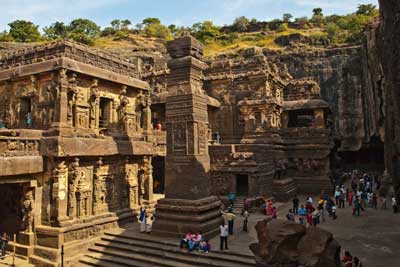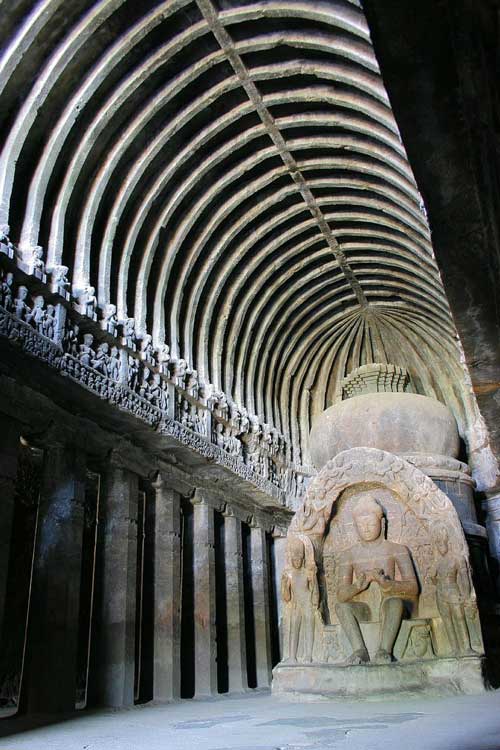
Considered as one of the largest rock-cut monastery-temple cave complexes in the world, Ellora is located around thirty kilometers away from the city of Aurangabad in the state of Maharashtra in India. Extending over an area of more than two kilometers, Ellora is an extraordinary and unique archaeological site, which presents surprising monuments and artwork of Buddhism, Jainism and Hinduism, dating from AD 600 to 1000. Locally known as Verul or Elura, which is the short form of the ancient name Elapura, Ellora with its unbroken sequence of monuments presents a clear picture of the ancient Indian civilization and the spirit of tolerance that was characteristic of ancient India.
The archaeological site, consisting of around 100 caves, was excavated out of the vertical basalt cliff in the Charanandri hills. Among those 100 caves, only 34 are open to the public. Those accessible caves include 12 Buddhist (caves 1-12), 5 Jain (caves 30-34) and 17 Hindus (caves 13-29) caves. It is estimated by the scholars that the Buddhist caves in the south, date from about 200 BC to 600 AD, the Hindu temples in the centre, date from about 500 to 900 AD and the Jain temples in the north, date from about 800 to 1000. The Hindu caves are the most dramatic in design, and the Buddhist caves contain the simplest ornamentation.
It is also estimated that, probably the earliest Ellora caves were built during the rule of the Hindu dynasties of Vakataka and the Traikutakas. In history, the Vakatakas are also known for sponsoring the Ajanta caves. However, it is also possible that some of the earliest Ellora caves, such as Hindu Cave 29, were built by the Shiva-inspired Kalachuri Hindu dynasty, while the Buddhist caves were built by the Chalukya Hindu dynasty. The later Hindu caves and early Jaina caves were sponsored by the Hindu Rashtrakuta dynasty, while the Yadava Hindu dynasty possibly built the last Jaina caves and also sponsored the other Jaina cave temples.


Among the Buddhist caves, cave 5 is especially grand and unusually deep with 17 cells and a large rectangular hall with two rows of 10 columns between which are set stone benches in two rows. However, cave 10 is most famous among this group, which is a worship hall known as the Vishvakarma cave. For its artistic finish, it is also known as Carpenter's Cave, because the rock has been given a finish that has the appearance of wooden beams. It presents a hugely impressive facade on two levels. The ground floor has a four-column facade while above is a veranda with a large central window. Deep inside the entrance, there is a cathedral-like Chaitya Griha, the prayer hall, with a 15-foot statue of Buddha seated in a preaching pose

Cave 30, known as Chhota Kailash, cave 32, known as Indra Sabha and cave 33 or Jagannath Sabha, are remarkable among the Jain caves.
Among the dramatically designed Hindu caves, cave 15, known as the Dasavatara cave, depicts all the Ten Avataras or the ten incarnations of Lord Vishnu in the top floor. It also has a beautiful sculpture of Lord Shiva as the Dancing Nataraja, the cosmic dancer. The entrance of the cave 21, otherwise known as Rameswara, features elegantly carved gigantic and voluptuous sculptures of goddesses Ganga and Yamuna on each side, which emphasizes their significance and importance in Indian culture. Said to be the oldest of the Hindu caves, the cave is decorated with several beautiful reliefs depicting the story of goddess Parvati's pursuit of Lord Shiva in her Tapasya or deep meditation. Cave 29 is one of the earliest excavations in Ellora and one among the largest. Also known as Dhumar Lena, it is equipped with three entrances with lion sculptures on either side of each entrance. The panels at the main entrance depict Ravana, the King of Lanka, shaking the Kailash Mountain, the abode of Lord Shiva. The panels at the southeast entrance exhibits the celestial marriage between Lord Shiva and Parvati and another one depicts Shiva and Parvati playing dice.




However, Ellora is famous for its cave 16, which is also known and renowned as Kailash Temple. It is considered as one of the most miraculous human creations in the world for its enormous size, beautiful structure, wonderful architecture and the unique way of construction. The huge temple is noted for its vertical excavation. It is not built, but cut and carved out of a huge and gigantic monolith. Maintaining the beauty of architectural planning, the hard rock was directly cut from the top to the base of the temple. In the process, an unbelievable quantity of about 400,000 tons of rock is carved out in a period of 20 years for completion of the temple. The Kailash temple is the largest monolithic human built structure of the world and is double the size of the Parthenon in Athens.



According to the scholars, the Kailash Temple was built during the reign of King Krishna I of the Rashtrakuta dynasty in 757 to 783 AD. The 98 feet tall temple is 164 feet deep and 109 feet wide, while the rear wall of its courtyard is 100 feet tall. The temple has the largest cantilevered rock ceiling in the world and apart from the secret passageways, it is well equipped with a good drainage system, connecting bridges and all carved out of this one single rock. The wonderful Kailash Temple is rightly considered as the jewel in the crown of Ellora.



Unlike the magnificent caves of Ajanta, Ellora Caves were never abandoned and forgotten for centuries. Throughout the history, they were admired and cared by people. It is one of the most popular tourist attractions in Maharashtra state and one of the older UNESCO World Heritage monuments.